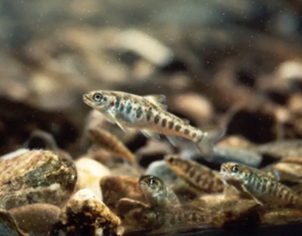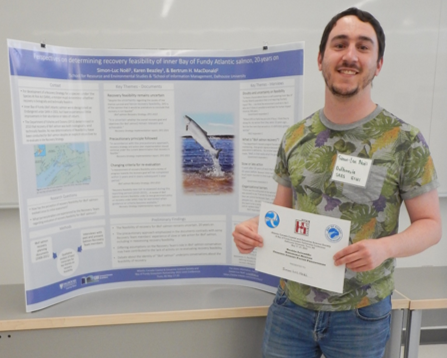Once an aquatic species is added to Canada’s list of endangered flora and fauna under the federal Species at Risk Act (SARA), does the best available information make its way into decision-making to promote the recovery of the species? Resource management, including the management of endangered species, can be challenging due to the involvement of many different actors, interest groups, and jurisdictional levels, as well as various biological, social, cultural, and economic factors at play. Information pathways can become convoluted when such actors and jurisdictions are involved in decisions on a given management problem.
Endangered species management under SARA can be characterized as a science-policy-action interface, and like many other such interfaces, may exhibit challenges such as conflicts between actors present at the interface, organizational factors such as bureaucracy and de-centralization that hinder communication between scientists and managers, or shifting perceptions among decision-makers about what types of information to prioritize. Though Canada’s Species at Risk Act was lauded for its evidence-based approach to endangered species management when it was first passed in 2002, recent analyses have highlighted problems with integrating evidence into the decision-making processes. While many such studies focus on the process of listing a species under the Act, fewer examine how pertinent evidence informs the ongoing management of an already-listed species. Understanding the barriers and identifying enablers to information flow (availability and access) at this interface is thus important to ensure that endangered species are managed in a way that lives up to SARA’s basis in evidence-informed management.
The research for my Master of Environmental Studies thesis focused on the case of inner Bay of Fundy (iBoF) Atlantic salmon (Salmo salar), which was designated as endangered by the Committee on the Status of Endangered Wildlife in Canada (COSEWIC) in 2001 and listed in Schedule 1 of SARA in 2003. Its endangered status was upheld in further evaluations by COSEWIC in 2006 and 2010, and the species continues to be the subject of recovery efforts. These efforts are supported by a Recovery Team composed of stakeholders and rights holders who have expertise or interest in iBoF salmon. These include the federal Departments of Fisheries and Oceans (DFO), and Parks Canada, Nova Scotia and New Brunswick government agencies, non-governmental organizations, forestry and aquaculture industry groups, and First Nations rights holders. Interactions between the Recovery Team, in its role as a meeting table for actors involved in iBoF salmon recovery, and the regulatory authorities for iBoF salmon—the Department of Fisheries and Oceans and Parks Canada—form the basis of the science-policy interface for the management of iBoF salmon.
 For my research, I chose to focus on the process for determining the feasibility of recovery of iBoF salmon. The initial determination was made as part of the 2010 Recovery Strategy drafted with the participation of the Recovery Team and use of the best available information at that time to determine whether it was biologically and technically feasible to recover the species. While the Recovery Strategy indicated that this feasibility should be reassessed every five years, no such reassessment has been completed as of 2024. Investigating the way that recovery feasibility is determined under SARA can help reveal the processes that shape which information is considered, how objectives are set, the barriers that may prevent the flow and use of information in recovery planning, and the steps that could be taken to improve the state of knowledge of science-policy interfaces within SARA decisions.
For my research, I chose to focus on the process for determining the feasibility of recovery of iBoF salmon. The initial determination was made as part of the 2010 Recovery Strategy drafted with the participation of the Recovery Team and use of the best available information at that time to determine whether it was biologically and technically feasible to recover the species. While the Recovery Strategy indicated that this feasibility should be reassessed every five years, no such reassessment has been completed as of 2024. Investigating the way that recovery feasibility is determined under SARA can help reveal the processes that shape which information is considered, how objectives are set, the barriers that may prevent the flow and use of information in recovery planning, and the steps that could be taken to improve the state of knowledge of science-policy interfaces within SARA decisions.
My research focused on two questions:
- Have the perspectives on the feasibility of recovery for iBoF salmon changed since the publication of the Recovery Strategy in 2010, and if so, how and why have they changed?
- What barriers or enablers are experienced by members of the iBoF salmon Recovery Team regarding the reassessment of the recovery feasibility for the species since 2010?
To answer these questions, I employed a mixed-methods case-study approach. Two data types were collected and analyzed: 1) policy documents related to iBoF recovery planning, such as the Recovery Strategy, Action Plan, and other relevant reports; and 2) responses to semi-structured interviews with key individuals and staff of organizations involved in recovery planning for iBoF salmon, primarily as members of the Recovery Team. I performed thematic analyses to identify key themes and subthemes relating to each of the research questions. Then, I integrated the results to develop a broad account of the changes in perspectives on recovery feasibility for iBoF salmon over time.
Many of the insights I gained shed light on barriers to the uptake and use of information in decision-making for managing iBoF salmon. The recovery planning documents and many interviewees highlighted the sheer difficulty of obtaining new ocean-based research information about iBoF salmon. Information about the species has been lost over time, and the population’s critically low abundance and unique circumstances led to its endangerment. The interviewees within and outside of government organizations acknowledged that producing conclusive results that could shed light on the feasibility of recovering the species and inform future management actions was substantially more difficult than for other endangered salmon such as the Southern Uplands population, located in rivers from Canso to Cape Split.
 A prominent barrier to information flow is mistrust between the actors in this science-policy interface. Some expressed mistrust in the information included in the Recovery Strategy to guide future management actions. Key examples were disagreements about how DFO characterized “good quality” freshwater and marine habitats, or whether aquaculture development in the Bay of Fundy potentially impacted iBoF salmon recovery. The interviewees also expressed mistrust when considering the roles that DFO and the Recovery Team played in producing and utilizing information for iBoF salmon management. Many interviewees from organizations outside DFO were uncertain about DFO’s intentions for recovery efforts since 2010. During this time the federal agency positioned itself as the final arbiter for the information that would be utilized and the management actions that would be allowed for the species. Mistrust among the actors at a science-policy interface can hamper information flow, whether because stakeholders are reticent to share information with the regulatory authority, or because the regulatory authority prioritizes certain types of information over others.
A prominent barrier to information flow is mistrust between the actors in this science-policy interface. Some expressed mistrust in the information included in the Recovery Strategy to guide future management actions. Key examples were disagreements about how DFO characterized “good quality” freshwater and marine habitats, or whether aquaculture development in the Bay of Fundy potentially impacted iBoF salmon recovery. The interviewees also expressed mistrust when considering the roles that DFO and the Recovery Team played in producing and utilizing information for iBoF salmon management. Many interviewees from organizations outside DFO were uncertain about DFO’s intentions for recovery efforts since 2010. During this time the federal agency positioned itself as the final arbiter for the information that would be utilized and the management actions that would be allowed for the species. Mistrust among the actors at a science-policy interface can hamper information flow, whether because stakeholders are reticent to share information with the regulatory authority, or because the regulatory authority prioritizes certain types of information over others.
Although barriers were prominently identified in my research, factors that enable information flow were also revealed. For example, opening up the kinds of information that DFO is prepared to consider as valid and scientific, such as research conducted by individuals and groups outside of DFO, including Indigenous knowledge, would serve to strengthen trust and the co-production of knowledge. Further, the expertise and resources of members of the Recovery Team could be more effectively leveraged to increase both the diversity and production of knowledge, while enhancing buy-in and legitimacy.
Through my analysis of the process of determining recovery feasibility for iBoF salmon, I identified logistical, organizational, and institutional factors that affected information flow at this science-policy interface. These factors have contributed to the lack of progress toward a recovery strategy for the species. Further research could develop a more detailed understanding of the factors that contribute to the movement and pathways of information (or lack thereof) in recovery planning processes for iBoF salmon, and other aquatic species listed under SARA. Improved understanding would support exploration of ways to address barriers and seize opportunities to enhance information flow at the science-policy interface.
Reference
Noël, S-L. (2024) An examination of recovery feasibility determination, and factors affecting its reassessment, for inner Bay of Fundy Atlantic salmon under the Species at Risk Act. [Master’s thesis, Dalhousie University]. DalSpace. http://hdl.handle.net/10222/84556
Author: Simon-Luc Noël
Image credits: Photograph of the Upper Salmon River, Alma, New Brunswick and photograph of Simon-Luc Noël with his prize-winning research poster (ACCESS-BoFEP conference) by Peter G. Wells. Photograph of Atlantic salmon parr by Peter Steenstra. Creative Commons license.
